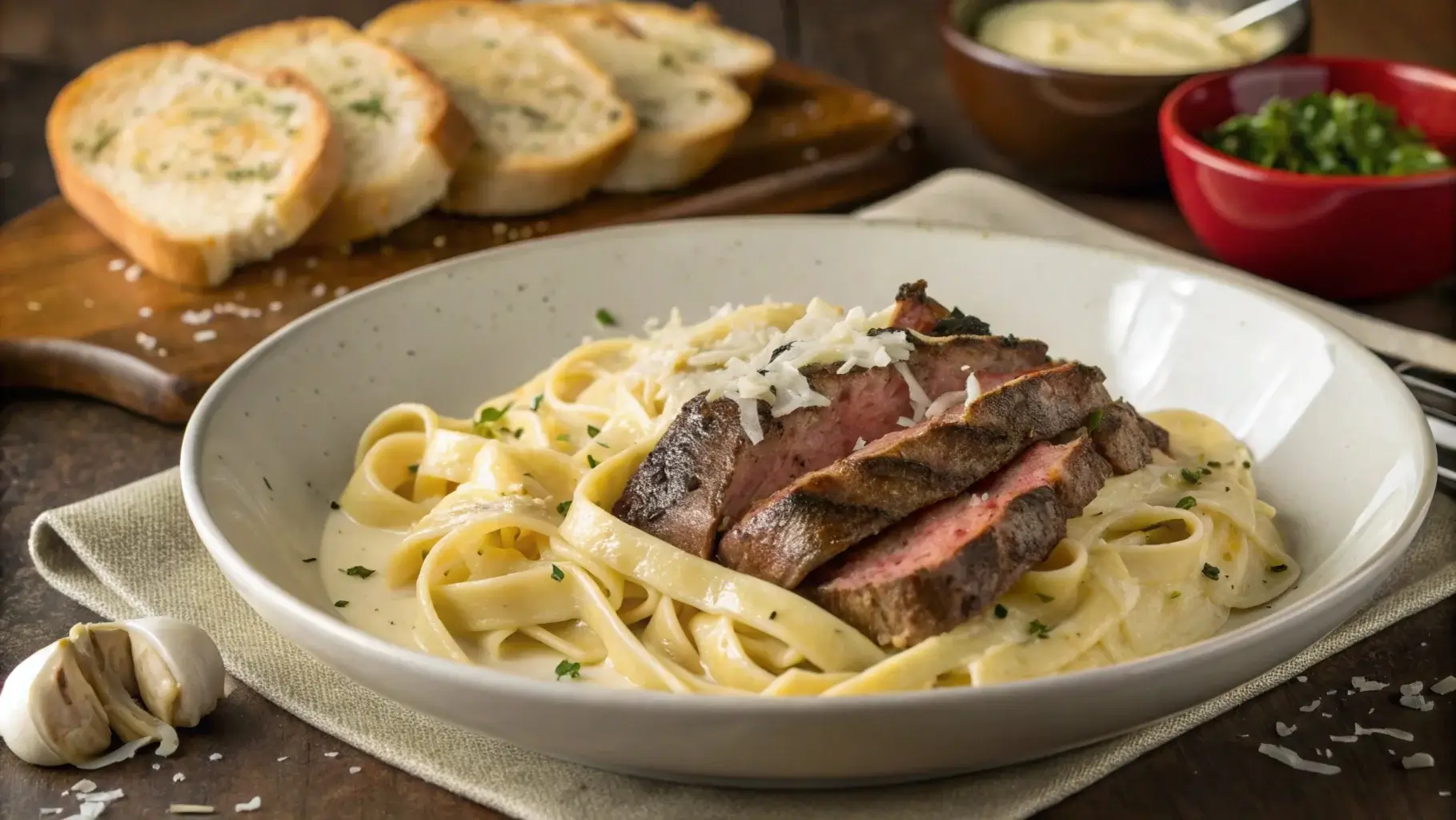Few meals capture the magic of comfort and indulgence quite like steak pasta. The combination of tender, juicy steak and perfectly cooked pasta, all wrapped in a flavorful sauce, creates a dish that’s both hearty and refined. Whether you’re craving creamy garlic richness or a zesty Mediterranean twist, there’s a variation of steak pasta to suit every mood and occasion. This guide will help you explore ingredient choices, cooking methods, and creative versions that’ll make your next meal unforgettable.
I remember the first time I made steak pasta—it was a total experiment. I had leftover steak from the night before and wasn’t sure what to do with it. On a whim, I boiled some fettuccine, whipped up a quick garlic cream sauce, and tossed it all together. The result? Absolute heaven. The tender steak melted into the creamy sauce, and the pasta soaked up all the rich flavors. That night, I realized how easy and customizable this dish could be, and it’s been a favorite in my kitchen ever since. Now, I’m excited to share all the tips I’ve learned so you can enjoy it too!
Let’s dive into everything you need to know to master steak pasta from start to finish.
Table of Contents
What is Steak Pasta?
Steak pasta is much more than just pasta topped with steak—it’s a decadent, flavor-packed meal that combines the richness of beef with the versatility of noodles. With countless variations, this dish has made its mark across kitchens worldwide, offering everything from hearty comfort food to elegant dinner options.
Overview of Steak Pasta
Steak pasta stands out because it merges two comfort food classics: succulent steak and pasta drenched in velvety sauces. While traditional Italian pasta often highlights tomato or olive oil-based sauces, steak pasta typically leans on creamier or richer options to balance the steak’s bold flavors.
But what makes it special? It’s the flexibility! You can dress it up with garlic, mushrooms, and balsamic glaze or keep it simple with butter and black pepper. No matter the preparation, it’s all about striking the right balance between the umami of the steak and the creaminess or tanginess of the sauce.
Different Types of Steak Pasta
- Creamy Garlic Steak Pasta: Rich and indulgent with a sauce made from heavy cream, garlic, and Parmesan.
- Mediterranean-Inspired Steak Pasta: Lighter and zesty with sun-dried tomatoes, olives, and fresh herbs like basil or oregano.
- Spicy Cajun Steak Pasta: If you like bold flavors, this version adds Cajun seasoning, bell peppers, and a kick of heat.
Whether you prefer it creamy or spicy, steak pasta guarantees satisfaction. Up next, we’ll cover how to choose the best ingredients to elevate your dish from good to great!
How to Choose the Best Ingredients for Steak Pasta
Crafting a mouthwatering steak pasta starts with selecting the finest ingredients. From choosing the right steak cut to picking a sauce that complements the dish, every choice matters. Let’s break down what you need to know to elevate your pasta game.
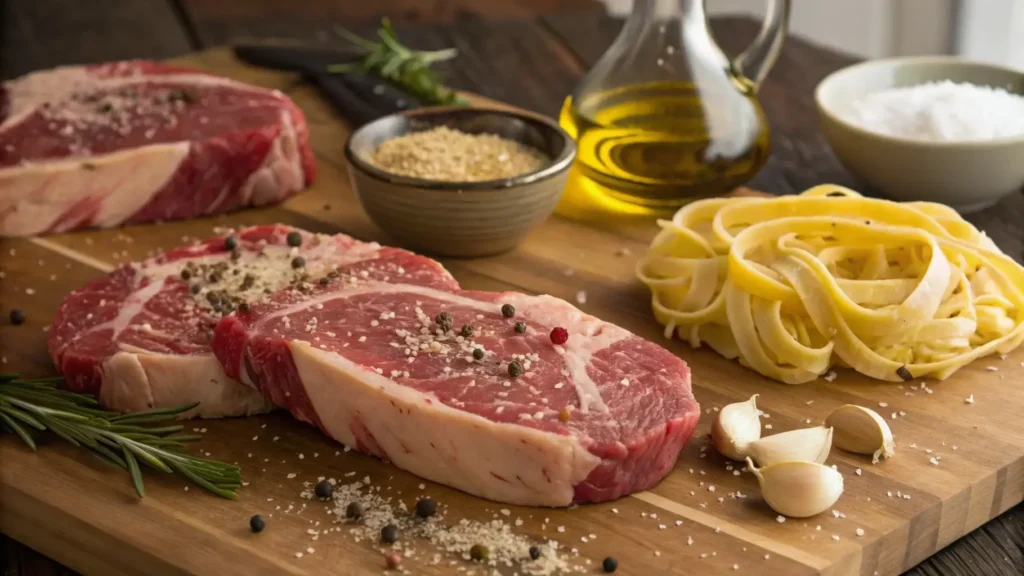
Selecting the Right Cut of Steak
The type of steak you choose can make or break the dish. For the best flavor and texture:
- Ribeye: Rich and juicy, ribeye is perfect for a hearty steak pasta with a creamy sauce.
- Sirloin: A leaner option that works well in recipes with light tomato-based or Mediterranean sauces.
- Flank Steak: Ideal for marinated dishes, especially when thinly sliced against the grain for tenderness.
Pro Tip: Marinate tougher cuts like flank or skirt steak in a blend of olive oil, garlic, and balsamic vinegar to tenderize them and enhance the flavors.
Picking the Perfect Pasta Type
Not all pasta is created equal when it comes to pairing with steak. Consider these options:
- Fettuccine or Tagliatelle: Broad and flat, these pastas hold creamy sauces well.
- Penne or Rigatoni: Perfect for absorbing sauces in every bite, especially in recipes with chunky ingredients like steak and mushrooms.
Fresh pasta often has a more delicate texture, making it ideal for luxurious versions of this dish, while store-bought pasta works just as well for quick, weeknight meals.
Choosing the Right Sauce
To highlight the richness of the steak:
- Creamy Alfredo or Boursin Sauce: For indulgent meals with garlic and herbs.
- Tomato-Based Sauces: Think light and tangy with hints of basil and sun-dried tomatoes, perfect for Mediterranean-style dishes.
- Garlic Butter Sauce: Simple, yet rich, and ideal for those craving a classic pairing.
Once your ingredients are ready, you’re just a few steps away from creating a restaurant-worthy steak pasta dish. Up next, we’ll walk you through the cooking process!
Step-by-Step Guide to Making Steak Pasta
Now that you’ve gathered the perfect ingredients, it’s time to put them all together. Follow these steps to create a flavorful, comforting plate of steak pasta that’s sure to impress.
Preparing the Steak
Cooking the steak correctly is crucial for a juicy and tender bite:
- Season the steak generously with salt, pepper, and optional garlic powder or Italian seasoning.
- Sear it in a hot pan with olive oil, about 3-4 minutes per side for medium-rare. Adjust the time if you prefer it well done.
- Let the steak rest for 5-10 minutes before slicing it thinly against the grain to retain its juices.
For a twist, try marinating your steak in balsamic vinegar or red wine to add depth.
Cooking the Pasta
Overcooked pasta can ruin your dish, so follow these tips:
- Boil pasta in salted water until it’s al dente (firm to the bite).
- Save a cup of pasta water before draining to help thicken your sauce later.
- If using fresh pasta, keep a close eye—it cooks much faster than dried varieties.
Making the Sauce
Here’s where the magic happens:
- For a creamy sauce: Sauté garlic and onions in butter, then add heavy cream, Parmesan cheese, and a touch of nutmeg for warmth. Stir until smooth.
- For a tomato-based sauce: Sauté garlic in olive oil, add crushed tomatoes, and season with basil and oregano. Simmer until the flavors meld.
- Want something lighter? A simple garlic butter sauce with parsley works wonders with grilled steak.
Combining Steak, Pasta, and Sauce
The final step ties it all together:
- Toss the drained pasta directly into the sauce, allowing it to absorb the flavors.
- Add the sliced steak on top or stir it into the pasta.
- Finish with Parmesan, a drizzle of olive oil, and a sprinkle of parsley or basil.
Your perfect steak pasta is ready to serve. Want more variation ideas? Stay tuned for popular versions of this timeless dish!
For more pasta cooking tips, you can explore this creamy garlic sauce recipe that complements steak beautifully.
Popular Steak Pasta Variations
No two steak pasta recipes need to be the same. With endless combinations of ingredients and flavors, you can tailor this classic dish to your taste. Below are some popular versions that you can try for dinner tonight!
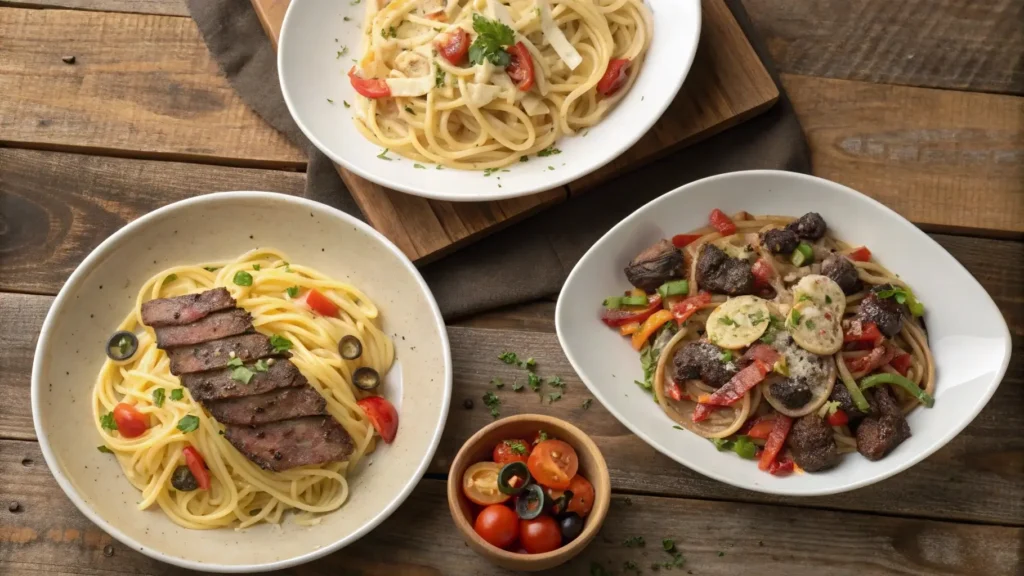
Creamy Garlic Steak Pasta
This indulgent variation is perfect for garlic lovers who enjoy rich, velvety sauces:
- Main Ingredients: Tender steak slices, heavy cream, Parmesan cheese, and plenty of garlic.
- Cooking Tip: Sauté garlic in butter until fragrant before adding the cream to infuse the sauce with flavor.
- Flavor Boost: Stir in sautéed mushrooms or caramelized onions for an earthy twist.
This variation pairs beautifully with fettuccine or tagliatelle, ensuring the sauce clings to every bite.
Mediterranean-Inspired Steak Pasta
Light, bright, and packed with fresh flavors, this version is perfect for warm evenings or when you’re craving something refreshing:
- Main Ingredients: Sun-dried tomatoes, olives, garlic, spinach, and grilled steak.
- Cooking Tip: Toss the pasta in a simple olive oil and garlic sauce, then top it with the steak and Mediterranean add-ins.
- Recommended Pasta: Penne or rigatoni for their ability to hold small bits of sun-dried tomatoes and olives.
This Mediterranean-style dish is a healthy alternative to cream-based pastas, offering a blend of hearty protein and zesty freshness.
Spicy Cajun Steak Pasta
Craving bold flavors and a bit of heat? Spicy Cajun steak pasta delivers a kick you won’t forget:
- Main Ingredients: Cajun seasoning, bell peppers, onions, and thinly sliced steak.
- Cooking Tip: Sauté the veggies in butter and Cajun spices before combining them with the cooked pasta and steak.
- Recommended Pasta: Penne or rigatoni, which can handle the sauce’s rich, spicy flavors.
Whether you want it smoky or fiery, this version will have you reaching for seconds.
Tips for Perfecting Steak Pasta at Home
Achieving restaurant-quality steak pasta at home isn’t as tricky as it sounds. These tips will help you avoid common mistakes and ensure every plate you serve is delicious.
Cooking Steak to the Right Doneness
A key aspect of this dish is ensuring your steak is cooked perfectly:
- For tender and juicy steak: Medium-rare (about 130°F) is often ideal because it’s juicy without being overly cooked.
- Let the steak rest: Resting for 5-10 minutes locks in its juices.
- Thin slices are key: Cut the steak thinly against the grain to enhance its tenderness.
Overcooking the steak can lead to a chewy texture, which will take away from the dish’s overall appeal.
Balancing Flavors in the Sauce
Your sauce shouldn’t overpower the steak but instead complement it. To achieve this:
- Add acidity (like a splash of lemon or balsamic vinegar) if the sauce feels too heavy.
- Don’t overdo the garlic—too much can overwhelm the steak’s flavor.
- Use pasta water sparingly to adjust consistency without diluting the taste.
If you’re aiming for a creamy sauce, stir in cheese slowly to avoid clumps.
Presentation and Garnishing Ideas
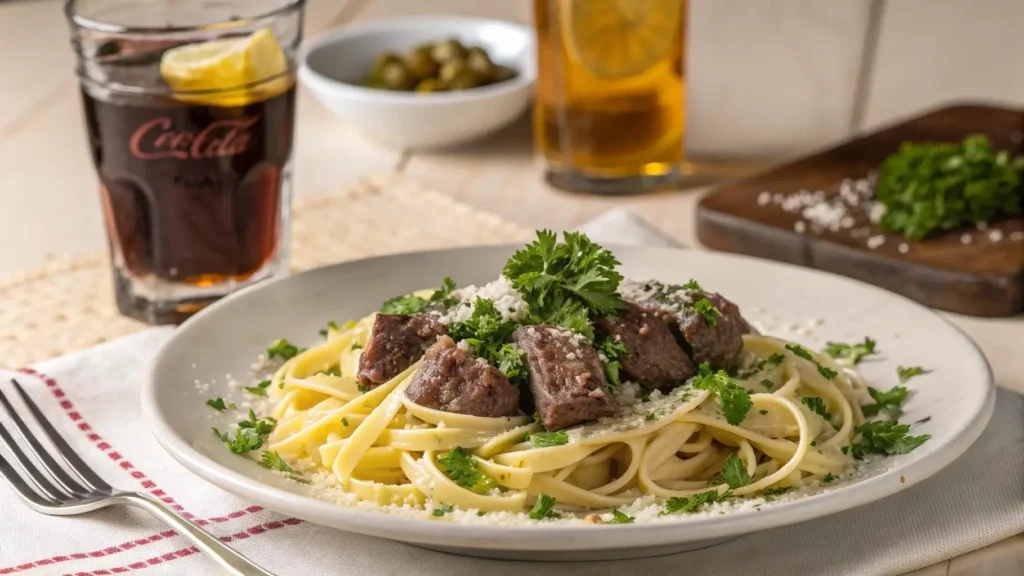
A little garnish can elevate the visual appeal and taste:
- Fresh herbs: Sprinkle fresh parsley or basil over the pasta for added aroma and color.
- Cheese: A dusting of Parmesan works wonders on creamy steak pasta.
- Drizzle: Finish with a drizzle of olive oil or balsamic glaze for a gourmet touch.
These finishing touches are what will have your guests thinking you ordered takeout from an upscale restaurant!
For more delicious home-cooked ideas, consider trying this creamy garlic-based recipe that pairs wonderfully with steak dishes.
Nutritional Benefits and Considerations
When you indulge in steak pasta, you’re not just satisfying your taste buds—you’re fueling your body with essential nutrients. However, like most hearty meals, balance is key to making it both delicious and healthy.
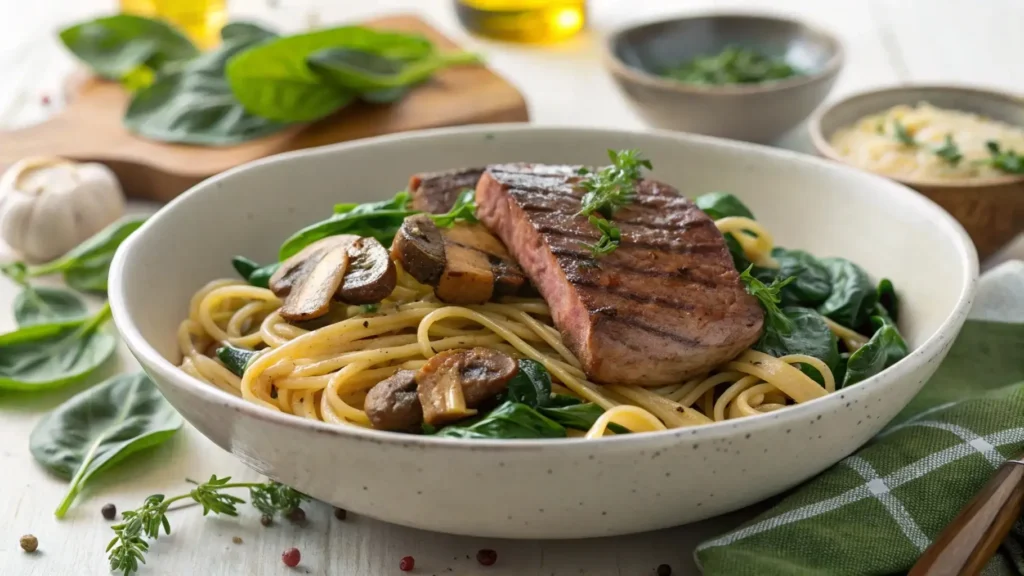
Protein and Carb Balance
The combination of pasta and steak provides a balanced meal rich in protein and carbohydrates.
- Steak: A great source of protein, iron, and zinc, which help build muscle and boost immunity.
- Pasta: Supplies your body with the carbs needed for energy, especially when you choose whole-wheat or high-protein varieties.
To create a healthier version, consider swapping traditional pasta for alternatives like chickpea or lentil-based options. They provide more fiber and protein while keeping the dish filling.
Calorie and Fat Content
Creamy sauces can quickly increase the calorie count, especially when made with butter, cream, or cheese. But don’t worry—there are simple ways to lighten it up without losing flavor:
- Replace heavy cream with Greek yogurt or cottage cheese for a protein boost and fewer calories.
- Opt for leaner steak cuts like sirloin instead of ribeye if you’re watching your fat intake.
Incorporating Veggies for Extra Nutrients
Adding veggies not only enhances the flavor but also packs in fiber, vitamins, and antioxidants:
- Spinach, mushrooms, and bell peppers blend seamlessly with most steak pasta recipes.
- Sautéed zucchini or broccoli can provide extra texture and a pop of color.
With the right ingredients, you can enjoy a hearty meal while staying on track with your nutritional goals.
Frequently Asked Questions (FAQs)
To help you master the perfect steak pasta, here are answers to common questions that often come up.
1. What type of steak is best for steak pasta?
Ribeye, sirloin, and flank steak are all popular choices. For a juicy and flavorful bite, ribeye works well with creamy sauces, while sirloin pairs nicely with tomato-based recipes. Flank steak, when marinated, is great for Mediterranean-style pasta.
2. Can I use whole-wheat pasta for a healthier version?
Yes! Whole-wheat pasta is a fantastic alternative because it’s higher in fiber and nutrients. If you’re seeking an even bigger health boost, you could try lentil or chickpea pasta for added protein.
3. What wine pairs well with steak pasta?
For creamy steak pasta, a glass of white wine like Chardonnay works beautifully. For tomato-based or spicy Cajun pasta, try a bold red wine such as Cabernet Sauvignon or Syrah.
4. How can I make the sauce creamier without heavy cream?
Greek yogurt, cream cheese, or even a blended mixture of cottage cheese and pasta water can give you a creamy consistency while keeping the dish lighter.
With these tips, you’re ready to conquer any variation of steak pasta. Don’t be afraid to experiment, and most importantly—enjoy every bite! 🍴
Savor the Perfect Bite of Steak Pasta
Steak pasta is more than just a meal—it’s an experience that blends the heartiness of succulent steak with the comforting goodness of pasta and rich sauces. Whether you’re indulging in a creamy garlic variation, a zesty Mediterranean twist, or a bold Cajun kick, this dish has something for everyone.
By choosing the right ingredients, cooking with care, and balancing flavors, you can easily recreate a restaurant-quality meal in your kitchen. Don’t forget to experiment with veggies, leaner cuts of steak, or even alternative pastas to make it your own. After all, the beauty of steak pasta lies in its versatility.
So, gather your ingredients, fire up the stove, and let your creativity flow. With the tips and recipes in this guide, you’ll be serving up delicious, soul-satisfying plates that are sure to leave everyone asking for seconds!
